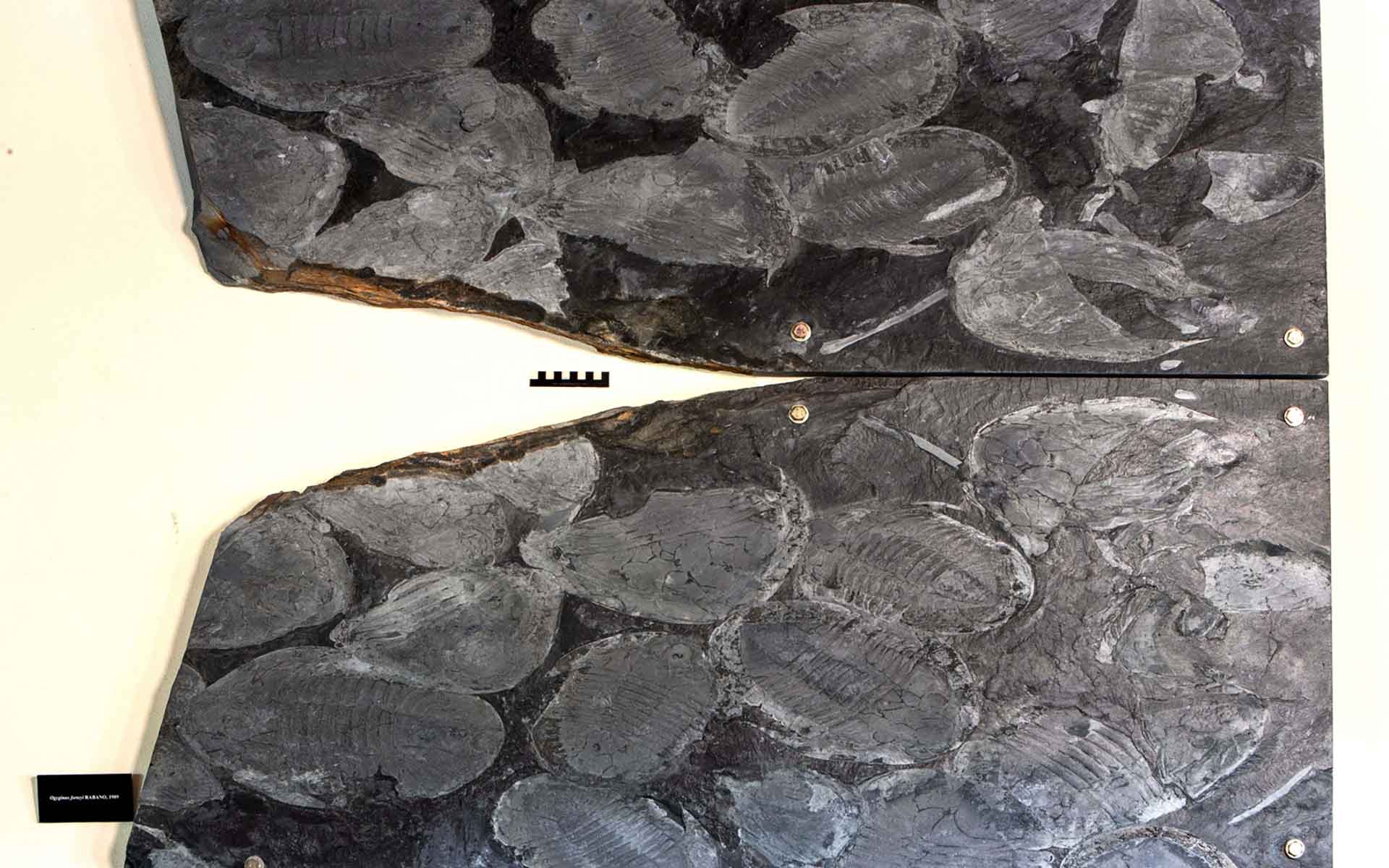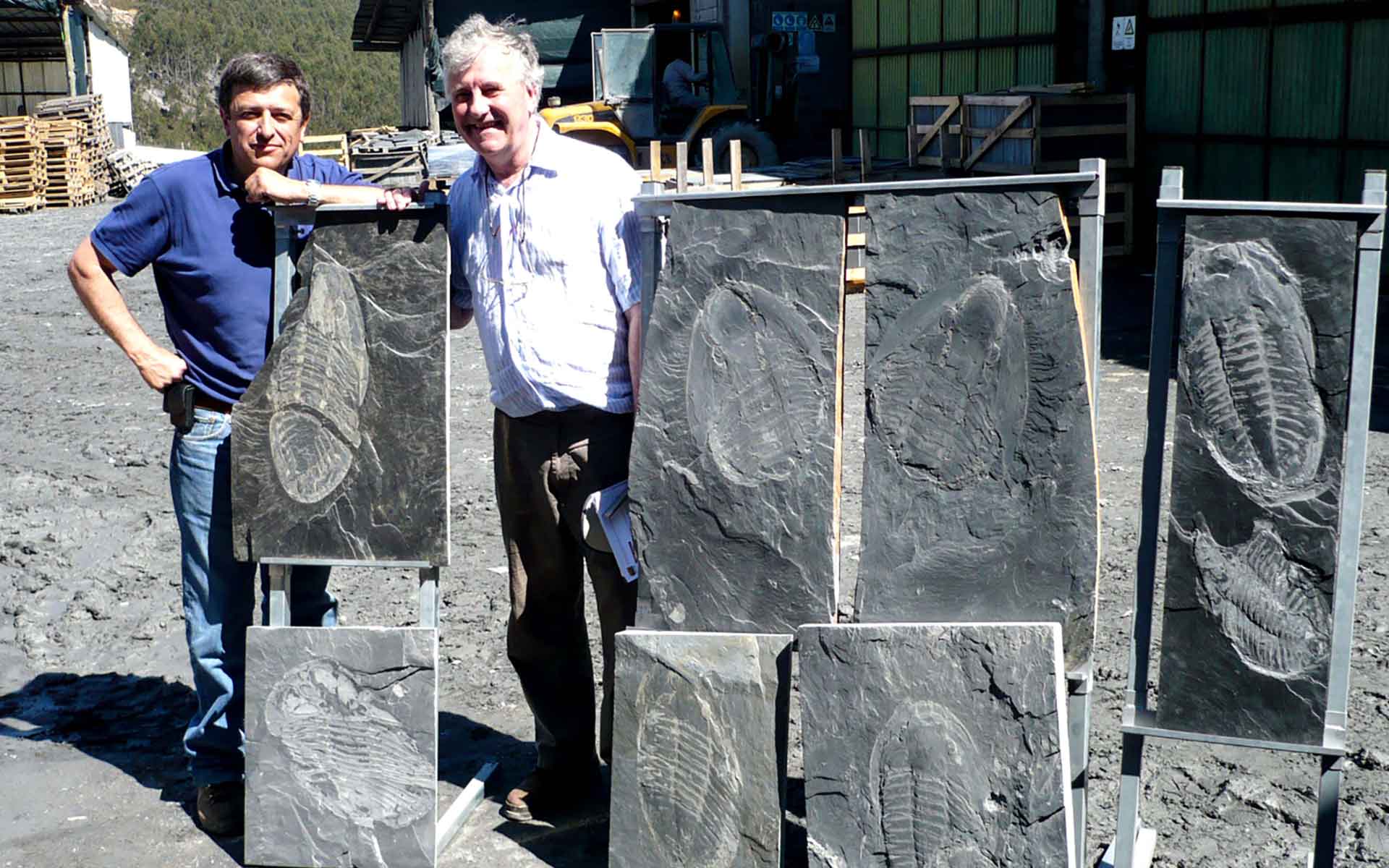
Monospecific association of Ogyginus forteyi (Rábano, 1989) from Canelas quarry, probably fossilized during the ecdysis process (external and internal molds). Scale bar = 10 cm.
Geological Period
Darriwilian – Middle Ordovician
Main geological interest
Paleontology
Location
Arouca Geopark, Portugal.
40°57’55.0″N, 8°13’04.0″W
Monospecific association of Ogyginus forteyi (Rábano, 1989) from Canelas quarry, probably fossilized during the ecdysis process (external and internal molds). Scale bar = 10 cm.
Fossils of the largest trilobites ever found, demonstrating a very active social life.
The fossil trilobites provide unique, valuable information on gigantism and social behavior among some species, as well as their interactions with other invertebrates preserved with the trilobites. Furthermore, the on-site museum is an extensively used educational resource, and development of the site serves as an example of cooperation between extractive industry, education, science, and sustainable development.
- Geological description
The Canelas Quarry exposes large surfaces of roofing slate in the village of Canelas, in the Arouca UNESCO Global Geopark (northern Portugal). These rocks were formed under oxygen-depleted conditions and have yielded a unique Ordovician fossil lagerstätte, which during the research made in the last two decades brought new information on the social behavior of trilobites. Besides that, it provides several of the world’s largest trilobite specimens (some reaching 80 cm), showing evidence of possible polar gigantism in some species, as well as numerous examples of monotaxic and polytaxic size-segregated autochthonous trilobite clusters, some of which contain as many as 1000 specimens. These reveal a very diverse social behavior, which includes temporary refuge from predation and synchronous molting and reproduction. Added to this is a diverse invertebrate fauna, which includes cephalopods, graptolites, hyolithids, conularids, gastropods, bivalves, rostroconchs, brachiopods, and echinoderms, as well as an assorted set of ichnofossils (Gutiérrez-Marco et al., 2009; Sá and Gutiérrez-Marco, 2006, 2008, 2015; Sá et al., 2021).
- Scientific research and tradition
Known since the mid-19th century, the giant trilobites of Canelas were the motive that inspired the creation of the Arouca UNESCO Global Geopark. This geosite is nowadays a scientific and tourist attraction worldwide recognised, already visited by palaeontologists and geologists during international congresses of trilobites and of Ordovician, among others.
- Reference
Gutiérrez-Marco, J.C. et al. (2009) ‘Giant trilobites and trilobite clusters from the Ordovician of Portugal’, Geology, 37(5), pp. 443–446. Available at: https://doi.org/10.1130/G25513A.1.
Sá, A.A. et al. (2021) ‘Giant trilobites and Other Middle Ordovician Invertebrate Fossils from the Arouca UNESCO Global Geopark, Portugal’, Geoconservation Research, 4(1), pp. 121–130. Available at: https://doi.org/10.30486/gcr.2021.1913689.1057.
Sá, A.A. and Gutiérrez-Marco, J.C. (2006) Trilobites gigantes das ardósias de Canelas (Arouca). Ardósias Valério&Figueiredo, Lda.
Sá, A.A. and Gutiérrez-Marco, J.C. (2008) ‘Giant Ordovician trilobites from Canelas (Arouca Geopark, northern Portugal)’, in Pre-Conference field trip guide. Madrid: Câmara Municipal de Arouca-Museo Geominero, p. 20.
Sá, A.A. and Gutiérrez-Marco, J.C. (2015) ‘Aroucaichnus igen. nov. y otros icnofósiles singulares del Ordovícico del Geoparque Arouca (Portugal)’, Boletín de la Sociedad Geologica del Peru, 110, pp. 8–23. Available at: https://doi.org/10.13039/501100003329.
- Author(s)
Artur Abreu Sá
Department of Geology, University of Trás-os-Montes e Alto Douro, 5000-801 Vila Real, Portugal


